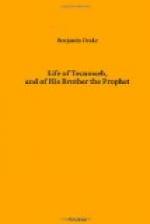Tecumapease, known also by the name of Menewaulakoosee, was a sister worthy of her distinguished brother Tecumseh, with whom, up to the period of his death, she was a great favorite. Sensible, kind hearted, and uniformly exemplary in her conduct, she obtained and exercised a remarkable degree of influence over the females of her tribe. She was united in marriage to a brave, called Wasegoboah, (stand firm,) who fell in the battle of the Thames, fighting courageously by the side of his brother-in-law, Tecumseh. In 1814, Tecumapease visited Quebec, in company with some other members of her tribe, from whence, after the close of the war between this country and England, she returned to the neighborhood of Detroit, where, not long afterwards, she died. Tecumseh is represented to have entertained for her a warm affection, and to have treated her, uniformly, with respect. He was in the habit of making her many valuable presents.
Sauwaseekau, is supposed to have been born while his parents were removing from the south to the Ohio. Concerning him few particulars have been preserved. He stood well as a warrior, and was killed in battle during Wayne’s campaign in 1794.
The fourth child, TECUMSEH, or the Shooting Star, is the subject of this biography.
Of the fifth, Nehaseemo, no information has been obtained.
The two remaining children, Laulewasikaw, called after he became a prophet Tenskwautawa, and Kumskaukau, were twins. Such is understood to have been the statement of the former, in giving the family pedigree. Other authorities[A] say that Tecumseh, Laulewasikaw, and Kumskaukau were all three born at the same time. The last named lived to be an old man, and died without distinction.
[Footnote A: John Johnston and Anthony Shane.]
Laulewasikaw, as will appear in the course of this work, lived to attain an extraordinary degree of notoriety. He became, under the influence of his brother Tecumseh, a powerful agent in arousing the superstitious feelings of the north-western Indians, in that memorable period of their history, between the year 1805, and the battle of Tippecanoe, in 1811, which dissolved, in a great measure, the charm by which he had successfully played upon their passions and excited them to action. The character and prophetical career of this individual will necessarily be fully displayed in the progress of this work. There is, however, one trait of his character which may be appropriately mentioned in this place—his disposition to boast, not only of his own standing and importance, but also of the rank and respectability of the family to which he belonged. As an instance of this peculiarity, and of his tact in telling a plausible tale, the following narration may be cited. It is an ingenious mixture of truth and fiction; and was written down by the gentleman to whom it was related by Laulewasikaw. The language is that of the individual to whom the narrative was made.




